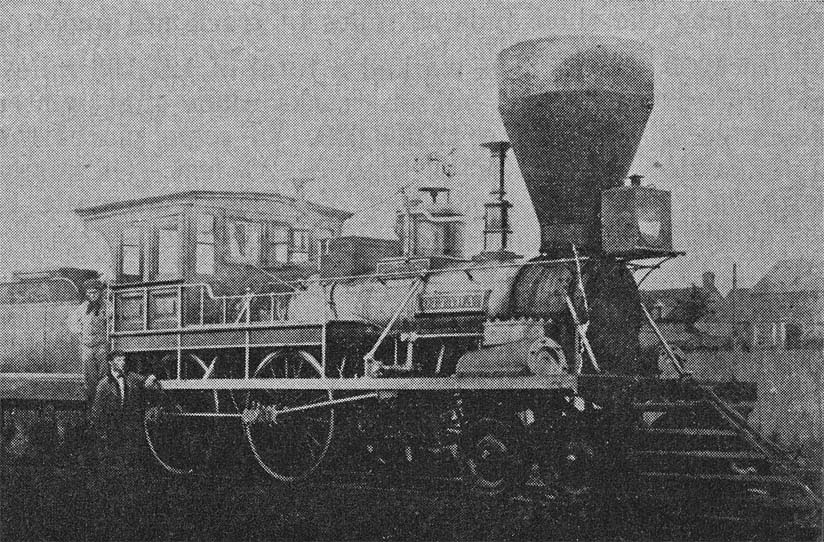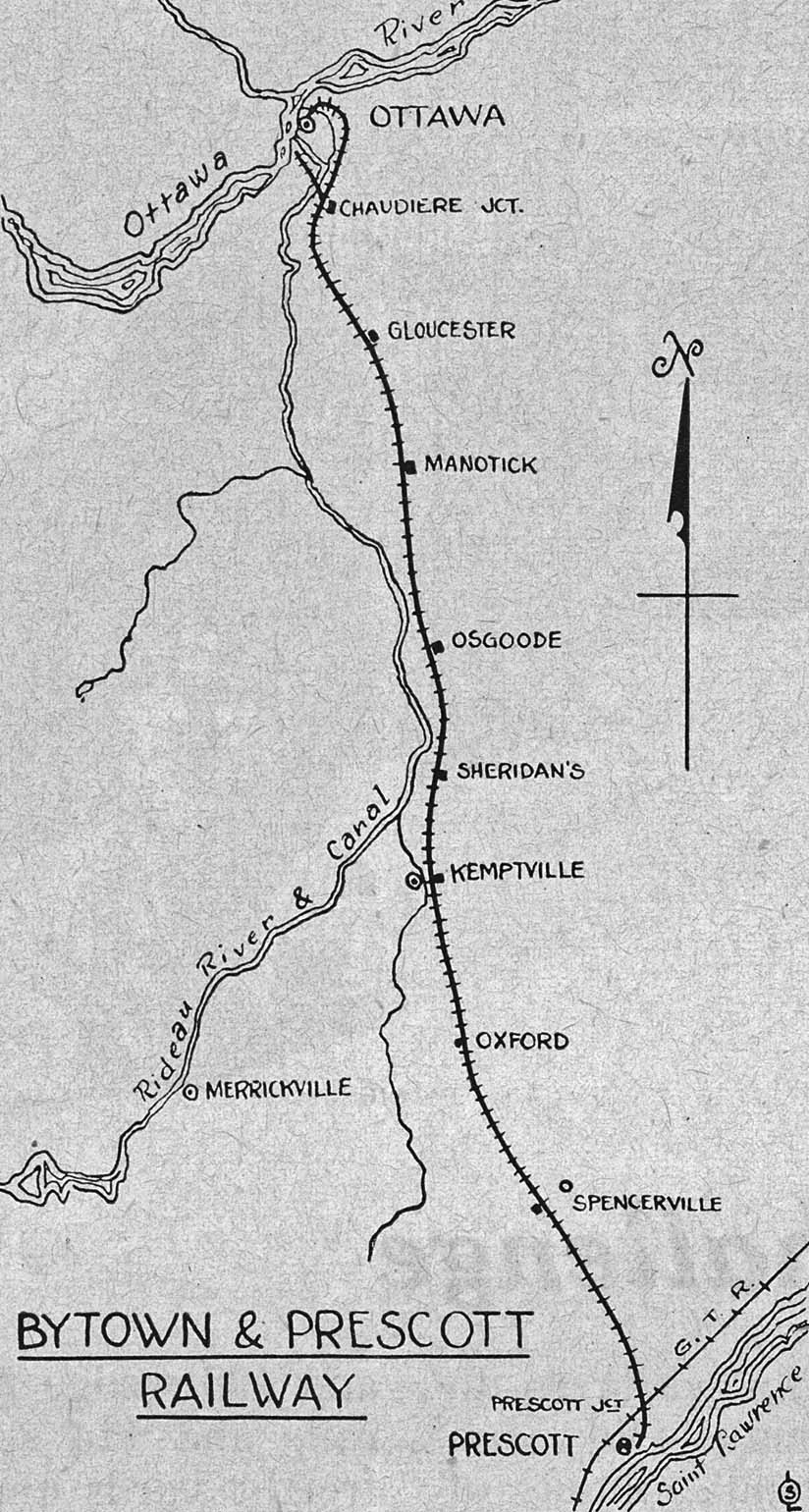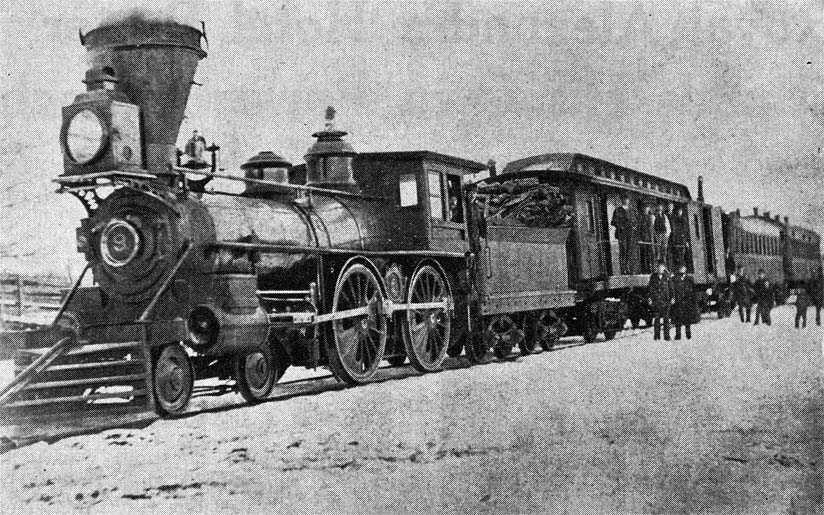

Historic Review of Bytown and Prescott Railway As Ottawa Observes Centenary First Rail Service
By Omer S. A. Lavallee
Bytown had good reason to be merry at Christmas in 1854. For one thing, the town's name was being changed and in a few short days, on the first day of the New Year, 1855, it would become known as Ottawa, after the mighty river which flows past its bluffs over the nearby Chaudiere Falls.
This town, first named in honor of the well known soldier-engineer, Colonel John By, whose work on the Rideau Canal has been recorded extensively elsewhere, was destined for great things as it faced the day of its rechristening. Three years afterward, history had it singled out to become the capital of the Province of Canada in British North America, and when the colonial provinces were united into a Confederation on that first Dominion Day, July 1st, 1867, the same river town would become the capital of the great nation we know and love today.

But, Bytown still had seven days to go before it would become Ottawa, it was Christmas, and overshadowing the holiday and the renaming of their town, its citizens were preparing for an event of the greatest local importance, the arrival of the first railway train on the barely-completed Bytown & Prescott Railway (B&P), Ottawa's first rail link with the outside world. Many of the citizens, indeed, most of them, had never seen a railway train or any piece of railway equipment before in their lives. Until the fall of 1854, the nearest Canadian railway was at Montreal, more than one hundred miles distant by Ottawa River steamer.
In the early fifties of the last century, when Canada was undergoing its first railway boom, Ottawa was the target for several railway lines, not the least of which was a trunk railway to unite Montreal and the Lake Ontario region, by way of Bytown. Such a railway would be militarily strategic, and it was desired to keep it as far away from the international boundary as possible. This seems ridiculous in our day and age, but one hundred years ago, the War of 1812 was still very fresh in the minds of older Canadians. This trunk railway was the Montreal & Bytown (M&B), and was even then in the course of construction, having opened its initial section just two months to the day before this Christmas of 1854, on October 25th.
As far as Bytown was concerned, however, the nearest railhead was still 65 miles down the Ottawa, at Grenville, Quebec, as the M&B had built only between Carillon and Grenville, and as later events proved, was destined to go no farther. The M&B might have been said to be on its way, but here was the Bytown & Prescott right at the doorstep.
It almost didn't get there either! There was an influential element in Bytown who, though they realized the benefits which would arise from a rail connection with the Saint Lawrence, nevertheless thought railway building a little premature. Bytown had water communication with Montreal via the Ottawa River, and with Kingston by way of the Rideau Canal. They were more than a little scornful when the Provincial Legislature granted a charter to the Bytown & Prescott Railway on August 10, 1850, but they were surprised when the first sod was turned in September, 1851, beginning work on the 57 mile line.
There was enough public confidence to encourage municipalities along the B&P to invest considerable sums in the enterprise, but the dubious ones were just waiting for some financial ill wind to come along and collapse the scheme like a house of cards. They nearly had their wish, too, when construction from Prescott reached Billings, a few miles south of Ottawa. Here, the Company ran out of the 54,000 tons of iron rails which had been bought in Wales in May of 1853. Robert Bell, the B&P's energetic and enthusiastic promoter was annoyed when this happened. He was far from defeated, however. Funds were pretty low, and in the face of some ill-timed scoffing on the part of his opposition, he laid wooden rails from Billings into Ottawa, and topped them with iron straps. It was only a railway of sorts, but it was a railway.
As the end of 1854 approached, it became clear to the backers of the B&P that they would have to make a show of confidence to the citizens of Bytown, for the railway's benefit. As a result, they decided to operate the first train on Christmas Day, even though the bridge over the Rideau River, within yards of the Rideau Falls, and just a few hundred feet short of the Sussex Street terminal, was as yet uncompleted.
The day came, and the B&P assembled what cars it possessed, coupled the four-wheeled engine "Oxford", the first, on the head end, and set out for Bytown. The train might have made a more impressive show with one of the larger engines at its head, such as the "Ottawa", but Bell decided not to tax the capacity of his wooden rails, and so the 1.8 ton Oxford was selected for the job. Just before five in the afternoon of Christmas Day, the citizens of the future Canadian capital smelled their first locomotive wood smoke as the diminutive Oxford and its train came slowly up along the Rideau River, and pulled up to a stop on the approach of the bridge-to-be. A boat ride was a rather ignominious end to an inaugural rail journey, but the passengers disembarked, were ferried over the Rideau River, and walking up Cumberland Street to the station, treated themselves to the banquet which had been prepared.
Examining the route of the B&P, one can not but wonder why the railway was not built to a point closer to the Chaudiere Falls, from its inception, it was felt that a large part of the southbound traffic would consist of timber which had been brought down the Ottawa in rafts. Accordingly, logic dictated that the railway should end at some point at or above the Chaudiere Falls. That this was not done is regrettable in view of the financial vicissitudes through which the company passed between the time of its opening, in 1854, and its reorganization in 1867. The official reason given for the fact that the line terminated in New Edinburgh, as the Sussex Street district was known, rather than farther to the west, was the supposed cost of expropriation and the difficulty of construction.
Actually, two of the most active shareholders in the company, Thomas McKay and his son-in-law, John McKinnon, influenced the board to have the railway terminate near the Rideau Falls. It should be said at this point that McKay owned a lumber mill adjacent to the station site and we leave the reader to draw his own conclusions. In point of fact, the usefulness of the railway was practically destroyed and the expected lumber traffic was not forthcoming, though a remedial measure was taken almost twenty years later when a branch was constructed to a station at what is now the Canadian Pacific's Broad Street freight shed.
Seven days after the first run, the company name was outdated by the renaming of Bytown. Accordingly, the company applied to the Provincial Legislature for permission to change its name to agree with the new civic designation, and a bill was passed, given Royal Assent on May 30th, 1855, changing its name to the Ottawa & Prescott Railway Company (O&P).
In 1856, the Grand Trunk Railway of Canada between Montreal and Toronto was opened, through Prescott. This might have been a practical traffic outlet for the Ottawa line, but the Grand Trunk was built to the statutory Provincial gauge of 5 feet 6 inches, while the O&P, which had been incorporated prior to the enactment of the Provincial Gauge Act in 1851, was built to the now almost universal standard gauge of 4 feet 81/2 inches. As a result, freight cars could not be interchanged, and loads had to be transshipped, a costly process. The depression of 1857 did not help the O&P, and its financial position steadily declined. A receiver was appointed by the Court of Chancery in 1858, after the railway had been seized by the principal creditors.
Among the creditors seizing the railway was the Ebby Vale Iron Company, of London, England, who had supplied the rails, for which they had been paid in sterling bonds, the interest upon which was now seriously in arrears. The receivership lasted from 1858 to 1865. Finally, in such desperate physical state that service was at a standstill, the railway was sold at auction on December 23rd, 1865, to the holders of the first mortgage bonds. This action in one stroke wiped out all of the share capital, the investments of the second and third mortgage holders, and a large amount of floating indebtedness. After effecting, at considerable cost, the necessary repairs to the railway, the line was granted a new charter as the Saint Lawrence & Ottawa Railway Company (SL&O), on December 21st, 1867, and service was resumed after a lapse of two years.
In the course of the period of 10 years between the time of opening of the railway and the termination of the receivership, travel conditions went from one extreme to the other. In the first years of operation, travellers wrote that the comfort could be compared with any other line in America. Even as late as 1860, Government reports show that passenger trains averaged 25 miles per hour on the line, between stops, the average passenger train consisted of three cars, while freight trains usually consisted of nine cars. In 1874, however, a well-known British traveller of the day wrote in what could only be considered as decidedly uncomplimentary terms, he said, in part "There is a sufficient similarity between an English and a Canadian railway for a person to see that they are of the same order of things, but yet the points of dissimilarity are very marked. The engine is a monstrous machine, with a "cow-lifter" slightly oscillating like a gigantic adder's tongue feeling the way. The guards, porters, and policemen are not in livery, and there is nothing to distinguish them from other gentlemen, so that a stranger desiring information or assistance stands an excellent chance of going without it."
In 1871, the new company built a branch from Ellwood to the Chaudiere, thereby remedying the error made originally in 1854 by building the terminal in Sussex Street. The new Chaudiere terminal attracted a considerable amount of lumber traffic, and this coupled with the narrowing of the Grand Trunk Railway's lines to standard gauge about the same time, allowed an uninterrupted flow of interchange traffic. The Chaudiere terminal gradually replaced the Sussex Street station after 1871.
Shortly after the Canadian Pacific Railway was formed in 1881, it adopted a policy of leasing and purchasing small lines in Eastern Canada, to integrate with the then-building transcontinental. The SL&O railway was one of these lines, and it was leased to the C.P.R. from September 26th, 1884.

The line possessed a varied collection of motive power and rolling stock, but there is one locomotive which far eclipsed its companions in fame, and that one was the "Lucy Dalton", number 9. After the SL&O was taken over by Canadian Pacific, the Lucy Dalton was sent to work in the North Bay area, where it was well remembered by the old-timers.
Today, the hundred-year-old route is still in use, as the Prescott Subdivision and the Sussex Street Subdivision of the Smiths Falls Division. It isn't the only route out of Ottawa any more, but the overnight Ottawa-Toronto train services use the line between Ottawa and Bedell. When train 33 left Ottawa on Christmas night, the passengers unknowingly commemorated that eventful Christmas one hundred years ago when the little "Oxford" arrived at the Rideau Falls with its train and ushered in the first century of rail service to the insignificant settlement which has since become our beautiful and well-known national capital.
 and is reprinted here with their permission. All photographs,
logos, and trademarks are the property of the Canadian Pacific Railway Company.
and is reprinted here with their permission. All photographs,
logos, and trademarks are the property of the Canadian Pacific Railway Company.
